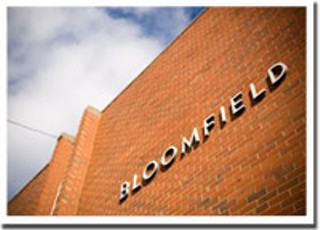If you visit Toronto, pop into 401 Richmond, a century-old renovated tin factory, on a busy downtown Spadina intersection. Check out the exposed brick, the generous windows, the art on the walls. Stop at the cafe before wandering through the galleries and studios. Stick around for a yoga class or relax in the rooftop garden. Now imagine that this is where you go to work—or play—every day.
The non-profit Imagine Bloomfield Society envisions a similar space here in Halifax. They want the Bloomfield Centre, a city-owned, three-building complex in north end Halifax, to thrive as a social and creative hub fastened with like-minded values, rather than bottom lines. And they’ve enlisted the president of Urbanspace Property Group, Margie Zeidler, to assist. She’s in town this weekend for a public talk and workshop dedicated to Bloomfield’s transformation.
Urbanspace owns and operates 401 Richmond and another Spadina building that houses for-profit and charitable organizations dedicated to social causes. “I see a lot of parallels with Bloomfield,” says Zeidler, who purchased 401 about 14 years ago. “I think that they’re both about building communities and creative tenants and creative people.”
Like Bloomfield—currently underutilized while the city reviews the facility—401 Richmond is a beautiful heritage building with a few rough edges. Perfect for artists and organizations that don’t have a lot of money and want to share things like photocopiers.
“The only people that we could think of that embraced this type of space were the artists and the creative sector,” says Zeidler. “Then we discovered it’s nice to not have a building filled with only artists, it’s interesting when different types of uses are going on, but all are respectful of a space centred on the arts. There’s an understanding it’s not a corporate environment—there are slop sinks in the corners on each floor. They’re nicely done and kept clean, but it’s not what you would find in an office tower.”
Susanna Fuller from Imagine Bloomfield says that while one of the Bloomfield buildings is already a vibrant mix of social services —16 groups occupy the space, including the Canadian Mental Health Association and the Centre for Diverse and Visible Cultures—the complex could offer much more.
“It’s a big issue in this city that artists can’t afford studios, non-profits are moving to Bayers Lake and Burnside because they can’t afford space, and that really affects their volunteer sector because no one is going to go out to Bayers Lake to volunteer,” Fuller says. “So why not do a really good needs assessment of the arts groups, studio spaces, environmental groups and social service groups. Do something interesting that mixes them all up, do some co-programming, maybe put in an outdoor sculpture garden or performing space.”
Imagine Bloomfield was initiated in 2005, when the Bloomfield Artists Collective and the Citadel Amateur Boxing Club were shut out of the Commons building after the city’s environmental testing found mould. They’re currently focused on a long-term feasibility study, with help from students from the Dalhousie School of Planning. Although Fuller acknowledges the city holds the reins to Bloomfield’s future, she hopes Zeidler’s visit will open up positive discussion about healthy, aesthetically pleasing development.
And there’s already proof this type of building works—401 Richmond caught the attention of all three levels of government, who conducted a joint study examining the building as an economic model for supporting small businesses. Tenants enjoy stability, spending more time focusing on work than space. Out of over 350 tenants at 401, Zeidler says there have only been two business failures.
“A supportive environment is so powerful,” says Zeidler, who won the 2003 Jane Jacobs Award, honouring those whose work contributes to the vibrancy of Toronto. “If you think of all the things governments do to support economic development, this would be such a powerful thing to do—to have hubs like this around a city. There’s a spark that happens within the building...The community spreads out, especially if you have public uses in it like cafes or galleries. And there’s a mutual respect. Everyone revels in being with each other.”
Margie Zeidler’s talk, “In the Spirit of Jane Jacobs: Development with Imagination,” February 1, 7pm, Dalhousie School of Architecture, Main Auditorium, 5410 Spring Garden. Imagine Bloomfield Design Workshop, February 3, 10am-2pm, Bloomfield Centre, 2786 Agricola.












